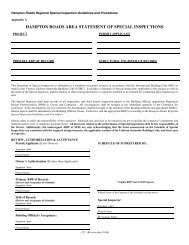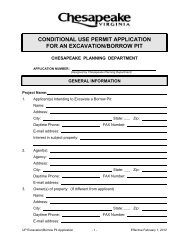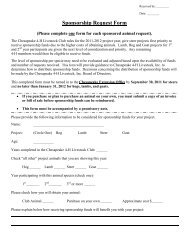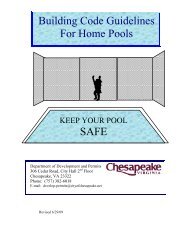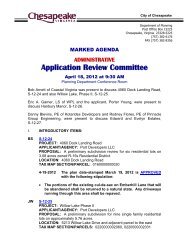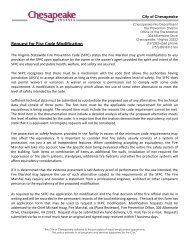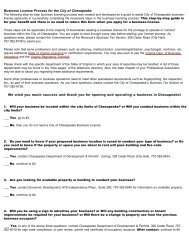Youth Flag Football Rules - City of Chesapeake
Youth Flag Football Rules - City of Chesapeake
Youth Flag Football Rules - City of Chesapeake
Create successful ePaper yourself
Turn your PDF publications into a flip-book with our unique Google optimized e-Paper software.
PARKS AND RECREATION DEPARTMENT<br />
2013 ATHLETIC RULES AND POLICIES<br />
FLAG FOOTBALL RULES<br />
<strong>City</strong> <strong>of</strong> <strong>Chesapeake</strong><br />
These Athletic <strong>Rules</strong> and Policies are approved by the <strong>Chesapeake</strong> Parks and Recreation<br />
Advisory Board. They are in effect for the 2013 Sport Season. The new rules are<br />
identifiable by bold type.<br />
ANTI-DISCRIMINATION STATEMENT<br />
"As a recipient <strong>of</strong> Federal financial assistance, the <strong>Chesapeake</strong> Parks and Recreation<br />
Department's programs and activities are open to all persons regardless <strong>of</strong> race, sex,<br />
religion, color, national origin, age or handicap."<br />
"If anyone believes he or she has been subjected to discrimination on the basis <strong>of</strong> race,<br />
color, national origin, age or handicap, he or she may file a complaint alleging<br />
discrimination with either Eugene Rosier, Equal Employment Opportunity Specialist,<br />
Department <strong>of</strong> Human Resources, Post Office Box 15225, <strong>Chesapeake</strong>, Virginia 23328,<br />
telephone 382-6492; or Director, Office for Equal Employment Opportunity Commission,<br />
World Trade Center, 101 West Main Street, Suite 4300, Norfolk, VA 23510."
2<br />
FLAG FOOTBALL RULES<br />
10.1 PLAYER ELIGIBILITY<br />
Age Requirement - Boys ages 6-8 as <strong>of</strong> September 30th <strong>of</strong> the current year.<br />
10.2 TEAMS AND COACHES<br />
Each team will consist <strong>of</strong> a maximum <strong>of</strong> 14 players assigned to a roster; seven players on<br />
a field.<br />
A. Coaches- There will be a limit <strong>of</strong> four coaches per team; one head coach and<br />
three assistants. Once coach must be on the field to huddle players on <strong>of</strong>fense and<br />
defense. Only the child (children) <strong>of</strong> the head coach and one assistant coach<br />
will be placed on their team during the draft.<br />
10.3. SCHEDULE<br />
A. Number <strong>of</strong> Games - Games will be played in accordance with the schedule set by<br />
the Parks and Recreation Department. Teams will play as close to 8 games as<br />
possible.<br />
B. Championships and Post Season Play - there will be no season champion or any<br />
post season games in the Training <strong>Football</strong> League. The program is designed to<br />
teach the basic fundamentals <strong>of</strong> football in a fun setting, without the pressures <strong>of</strong><br />
winning or losing. Game scores and team standings will not be kept in the<br />
Training League.<br />
10.4 PRACTICE<br />
A. Practice Limits - Teams are limited to three 1½ hour practice sessions, including<br />
scrimmages and chalkboard sessions, within a calendar week. If teams have one<br />
game within a calendar week, teams are limited to two 1½ hour practice sessions.<br />
If teams have two games within a calendar week, teams are limited to one 1½<br />
hour practice session. Practices are not permitted on the same day as a scheduled<br />
game, unless the game was postponed on that day.<br />
During school nights, the Training League players are to practice no later than<br />
8:00 PM.<br />
B. Sundays - Games and practice will not be held on Sundays.
3<br />
C. Scrimmages - Teams may scrimmage against teams in their age category within<br />
their athletic area. Teams are limited to two pre-season scrimmages in their age<br />
category with the other <strong>Chesapeake</strong> athletic areas. These scrimmages must be<br />
approved by the Parks and Recreation Department. No practices or scrimmages<br />
will be allowed with teams other than <strong>City</strong> <strong>of</strong> <strong>Chesapeake</strong> teams.<br />
10.5 FLAG LEAGUE PLAYING RULES<br />
The flag football program provides youngsters with the opportunity to enjoy the game<br />
and develop and practice football skills at an early age. Conventional football does not<br />
accomplish these goals because young players do not get the opportunity to learn and<br />
practice the various skills <strong>of</strong> the game. The average youngster can learn to play and<br />
enjoy football with good instruction and day-to-day experience.<br />
For the beginner, the learning experience must be fun, with ample opportunity to practice<br />
all the fundamental <strong>of</strong> the sport.<br />
The <strong>Flag</strong> League <strong>Football</strong> Program should be organized to teach and develop football<br />
skills, teamwork, sportsmanship and have fun. This is an important period in every<br />
child's development. All players should be encouraged to do their best by managing<br />
personnel. The <strong>Flag</strong> League should be fun. If it isn't fun, it isn't a recreational program.<br />
The key to success is careful selection <strong>of</strong> coaches. If the goal is to provide a program<br />
with maximum benefits, only the very best people should be selected to serve.<br />
The overall concept <strong>of</strong> the <strong>Flag</strong> League should be total participation in a congenial<br />
environment under the supervision <strong>of</strong> competent and concerned adults. The leadership<br />
must reflect a positive and constructive direction tempered with patience. If this program<br />
is worth doing, it should be done well.<br />
A. Age Limit - Players must be six years <strong>of</strong> age as <strong>of</strong> September 30th <strong>of</strong> the current<br />
year and cannot turn nine years <strong>of</strong> age as <strong>of</strong> September 30 <strong>of</strong> the current year.<br />
B. Roster Limit - There will be a maximum <strong>of</strong> 14 players on a team. Player<br />
distribution will be conducted by blind draw and will be handled by the<br />
Department <strong>of</strong> Parks and Recreation staff. Players will be redistributed each year.<br />
C. Game Player Limit - Teams must begin and end game with 7 players on the field.<br />
D. Required Playing Time<br />
1. Each player is required to start and finish two full quarters <strong>of</strong> each game<br />
without interruption except in the case <strong>of</strong> injury or illness or other<br />
emergency situations. There will be no substitutions in the first and<br />
second quarters except in the case <strong>of</strong> injury, illness or ejection.
4<br />
These players must be brought to the attention <strong>of</strong> the athletic staff. During<br />
the third and fourth quarters, players who have played their two full<br />
quarters <strong>of</strong> playing time may enter the game as a substitute or be<br />
substituted for. Participation does not have to be in consecutive quarters.<br />
2. A coach who has a player arrive after the start <strong>of</strong> the game but prior to the<br />
start <strong>of</strong> the third quarter must play him in two full quarters <strong>of</strong> playing time.<br />
However, if a player arrives after the start <strong>of</strong> the third quarter, the coach<br />
has the option to play this player or not in the fourth quarter. If the tardy<br />
player is placed in the game at the beginning <strong>of</strong> the quarter, he cannot be<br />
replaced unless an injury occurs.<br />
E. Offensive and Defensive <strong>Rules</strong><br />
1. Offensive player can receive the ball from the center anywhere behind the<br />
line <strong>of</strong> scrimmage.<br />
2. All players are eligible to receive a pass.<br />
3. The set position for an interior lineman is hand on knees in a two-point<br />
stance. The set position for an uncovered lineman other than an interior<br />
lineman and/or all other players is either the two-point stance or standing.<br />
4. The center shall be allowed sufficient time to snap the ball and assume a<br />
blocking position. Determination <strong>of</strong> “sufficient time” shall be at the<br />
discretion <strong>of</strong> the referee whose sole purpose is to protect the safety <strong>of</strong> the<br />
child centering the ball. To prevent neck injuries, center attempting<br />
“shotgun snaps” shall be afforded a safe distance by the defender. A<br />
defensive player who fails to adhere to the <strong>of</strong>ficial’s definition <strong>of</strong><br />
“sufficient time” to allow the center snap the ball and assume the blocking<br />
position shall be penalized “Unsportsmanlike Conduct Dunking the<br />
Center.” Penalty: 15 yards.<br />
5. 3 or 4 point stances are prohibited and shall result in an “Illegal<br />
procedure” penalty.<br />
6. Center cannot carry the ball from scrimmage but can receive a pass.<br />
7. The ball carrier must run to avoid tacklers. Deliberate charging <strong>of</strong> an<br />
opponent is 10 yards penalty. Officials will use the same judgment on<br />
charging and blocking by <strong>of</strong>fensive or defensive players as in basketball.<br />
Brushing contact and unavoidable contact is not willful charging.
5<br />
8. A ball carrier may not stiff arm a defender or protect his flags by<br />
deflecting the defender with the use <strong>of</strong> his hands. A ball carrier that<br />
impedes the legal attempt by the defender to de-flag him by protecting<br />
his flags with his hands shall be penalized for “<strong>Flag</strong> Guarding.”<br />
Penalty: 10 yards.<br />
9. No forceful charging or aggressive blocking by players is permitted.<br />
Penalty: 10 yards.<br />
10. If a defensive player tackles a ball carrier, penalty is half the distance to<br />
the goal. If the runner was in the clear, and in the opinion <strong>of</strong> the referee<br />
would have scored except for being tackled, a touchdown shall be<br />
allowed.<br />
If a defensive player reaches across the body <strong>of</strong> the ball carrier to pull flag<br />
and contact is made which impedes the progress <strong>of</strong> the runner, the<br />
responsibility <strong>of</strong> the contact lies with the defensive players. Penalty 10<br />
yards.<br />
11. An <strong>of</strong>fensive player in front <strong>of</strong> the ball carrier must stop or alter his run to<br />
avoid intentional contact with a defender. Penalty: 10 yards.<br />
12. The ball carrier is down at the spot where the tackler pulls out one <strong>of</strong> the<br />
flags. Unnecessary roughness by tackler or elbowing by runner is 10-yard<br />
penalty. In the event <strong>of</strong> a flag dropping without being pulled by a tackler,<br />
ball is dead at this point.<br />
1. <strong>Flag</strong> Guarding – Ball carriers shall not use hands to guard their<br />
flags. Penalty 10 yards.<br />
13. Offensive Line - A minimum <strong>of</strong> 4 players must be on the line <strong>of</strong><br />
scrimmage. Defensive Line - A minimum <strong>of</strong> 3 players must be on the line<br />
<strong>of</strong> scrimmage.<br />
14. Players may not interlock their legs at the line <strong>of</strong> scrimmage. The defense<br />
shall position themselves in a “heads-up” position when lining up across<br />
from an <strong>of</strong>fensive interior lineman.<br />
15. A player leaving his feet to go over an opposing player shall be<br />
penalized for “Hurdling.” In the open field, game <strong>of</strong>ficials shall<br />
determine if the <strong>of</strong>fensive player gained an unfair advantage by hurdling.<br />
Penalty: 10 yards.
6<br />
F. Unsportsmanlike Conduct - 10 yards and/or ejection.<br />
G. First Downs- A team makes the first down when the ball advances to or beyond<br />
the field designated 20 yard markers in four downs or less.<br />
H. Scoring - After touchdowns an extra point try may be permitted. Only passing<br />
and running attempts - no kicks.<br />
I. Kicking<br />
J. Punts<br />
1. Kick<strong>of</strong>fs will be at the 45-yard line on a 100-yard field and the 35 yard<br />
line on an 80-yard field. If kick goes out <strong>of</strong> bounds, ball is placed at the<br />
point it goes out or the 50 yard line on a 100-yard field and the 40 yard<br />
line on an 80-yard field, whichever is to the <strong>of</strong>fensive team's ad-vantage.<br />
2. Receiving team must line up inside their 45-yard line on a 100-yard field<br />
and 35-yard line on an 80-yard field, and have 3 players on the line.<br />
3. No on-side kicks allowed. Penalty: 5 yards.<br />
4. The kick<strong>of</strong>f is always the possession <strong>of</strong> the receiving team.<br />
5. The ball may be advanced by the receiving team after it touches the<br />
ground.<br />
1. All attempted punts must be announced.<br />
2. The defensive team may not rush. The punting team may not go down<br />
field until the ball is kicked. Penalty: 5 yards and re-kick.<br />
3. The defensive team must keep three players at the line <strong>of</strong> scrimmage until<br />
the punt is made. Penalty 5 yards.<br />
4. The punter must be at least 5 yards behind the line <strong>of</strong> scrimmage. Penalty:<br />
5 yards.<br />
5. The punt is always the possession <strong>of</strong> the receiving team.<br />
6. The ball may be advanced by the receiving team after it touches the<br />
ground.
7<br />
K. Fumbles<br />
1. A fumble is dead at the point the ball touches the ground after coming in<br />
contact with <strong>of</strong>fensive player and goes to the team who fumbles or<br />
dropped the ball. Exception: 4th down situation.<br />
2. The ball cannot advance forward on a fumble.<br />
L. Blocking<br />
1. The <strong>of</strong>fensive player may protect the player with the ball by screening as<br />
done in basketball. Players may use the open palm or forearm to block.<br />
Any use <strong>of</strong> other parts <strong>of</strong> the body to block is prohibited and a player shall<br />
be penalized. “Illegal Block”<br />
2. A player may not leave his feet to block. “Illegal Block”<br />
3. Blocking shall occur only in the area between the player’s shoulders to his<br />
waist on the front <strong>of</strong> his body. A player who blocks below the waist<br />
(“Illegal Block”) trips another player (“Tripping”), or blocks a player in<br />
the back (“Clipping”) shall be penalized.<br />
4. If an <strong>of</strong>fensive player legally engages a defender in a blocking position<br />
and that defender subsequently turns his back, the player is allowed to<br />
continue his block, even if it occurs in the back, until the defender breaks<br />
contact from the <strong>of</strong>fensive blocker.<br />
5. Screening shall be defined as an <strong>of</strong>fensive player maintaining a position<br />
between the defensive player and the player with the ball. No part <strong>of</strong> the<br />
screeners body except their feet may be in contact with the ground. (No 3-<br />
point stance). Movement <strong>of</strong> the screeners body that causes contact with<br />
the defender is considered an illegal screen. The screener may not cause<br />
intentional contact with their elbows, forearms, hands, head, shoulders,<br />
hips. Incidental contact is unavoidable. Whether stationary or not, all<br />
blocking violations are 10 yard penalties.<br />
6. No defensive player can line up on the defensive line in front <strong>of</strong> the<br />
<strong>of</strong>fensive center/snapper. Illegal Formation Penalty: 10 yards.<br />
7. A defensive player must go around an <strong>of</strong>fensive player at all times. They<br />
may touch the screener with their hands only to maintain their balance in<br />
going around the screener. Pushing, pulling or charging across a legal<br />
screener is a charging violation. Penalty: 10 yards.
8<br />
M. Length <strong>of</strong> Games<br />
1. All games will consist <strong>of</strong> four quarters, eight minutes each.<br />
2. In the event a game must be suspended because <strong>of</strong> conditions which make<br />
it impossible to continue play, the head referee shall declare it an <strong>of</strong>ficial<br />
game if one complete half or more <strong>of</strong> the game has been played. If less<br />
than one-half <strong>of</strong> the game has been played, the game will be rescheduled<br />
from the start.<br />
3. Regulation clock will be in effect.<br />
4. Time period between quarters and halves - There will be a one-minute<br />
period between each quarter and a five-minute period between the halves.<br />
5. Time outs - Each team will have two one-minute time outs per half. Time<br />
outs do not carry over.<br />
N. Officials - There will be two <strong>of</strong>ficials per game. In the event <strong>of</strong> no <strong>of</strong>ficials, two<br />
coaches may be asked to <strong>of</strong>ficiate.<br />
O. Equipment<br />
1. Care and Return- The <strong>Chesapeake</strong> Parks and Recreation Department<br />
furnish necessary equipment to operate the Training <strong>Football</strong> Program. It<br />
is the coach's responsibility to make sure the equipment is properly cared<br />
for and returned to the Department within ten days <strong>of</strong> the last played game<br />
<strong>of</strong> their season.<br />
2. Shoes - Official rubber molded shoes or tennis shoes may be worn.<br />
3. Jerseys - Departmental sport shirts will be utilized.<br />
4. Mouthpieces – are required and may be transparent or in color. Elbow<br />
pads and kneepads are optional.<br />
5. Ball Type – Pee Wee size.<br />
6. <strong>Flag</strong>s will be provided by the Department.<br />
P. Playing Field - 80 yards long.




